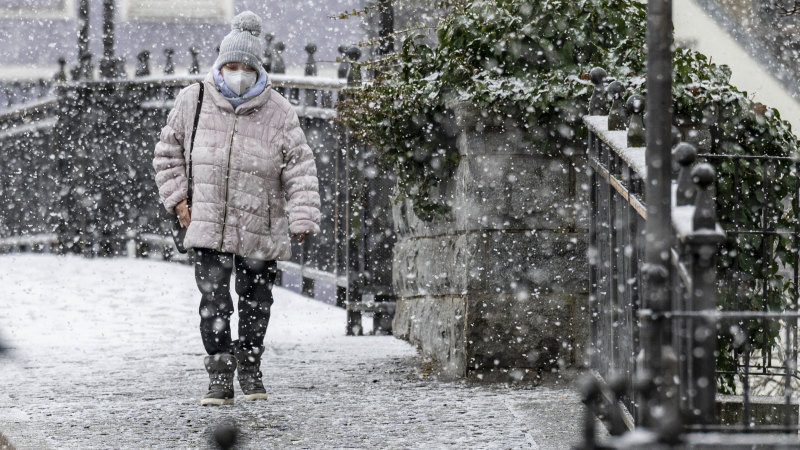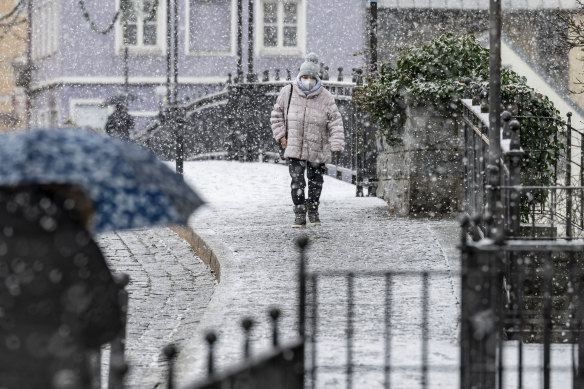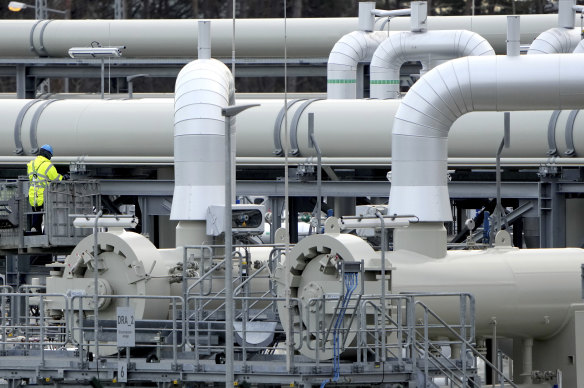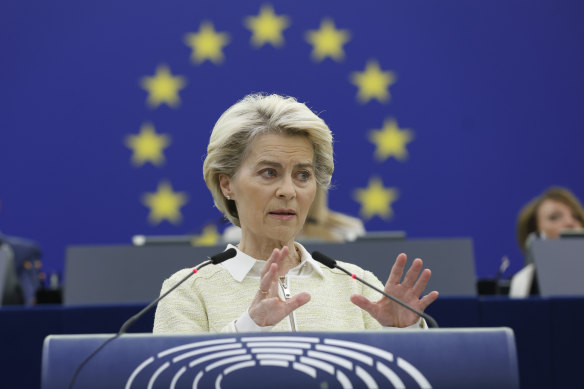Mission impossible: Europe’s desperate fight to solve its energy crisis as winter looms
The Europeans are faring better than they expected in filling up their gas storage reservoirs ahead of the northern winter but that relative success in responding to Russia’s weaponising of its gas is coming at a very steep price and forcing an urgent reconsideration of the structure of their energy markets.
Across Europe gas reserves are an average of about 80 per cent of capacity, a level the European Union had targeted to achieve by November 1. In Germany, hardest hit by Russia’s throttling of its gas supply, reserves will hit 85 per cent of capacity next week. France is at 90 per cent.
Both the EU and the UK are trying to devise short term and longer-term responses to their energy crisis but there is always the risk of unintended consequences.Credit:AP
While the EU is well ahead of the timelines it set itself, that success has come at extreme cost and doesn’t guarantee there won’t be rationing of gas or energy blackouts if there’s a cold winter. Even at 100 per cent of the EU’s storage capacity, those reserves would still account for only 25 to 30 per cent of demand.
The unexpected success in building the reserves did produce some relief from gas prices that have soared since Russia invaded Ukraine and then responded to the West’s sanctions by reducing the volumes of gas it pipes into Europe – about 40 per cent of Europe’s pre-invasion gas demand – to a trickle.
Despite the closure of the Nord Stream pipeline for three days of “maintenance” this week, gas prices have fallen sharply after the weekend announcement that Germany’s reserves had built much faster than anticipated.
The benchmark Dutch gas futures price fell more than 20 per cent initially but traded around 16 per cent lower and the price of German power was down nearly 30 per cent.
That’s providing only limited relief, however, because European gas prices are still nearly 10 times what they were a year ago. In the UK gas prices are about seven times higher than they were last year, having doubled in four months.
About two-thirds of Europe’s gas-reliant fertiliser production has been paralysed by the gas crisis, adding spiralling food costs to an inflation rate that continues to rise.
On Tuesday. Germany’s inflation rate hit 8.8 per cent and is heading towards double-digit rates and its highest level for nearly half a century, with energy prices up 36 per cent and food prices almost 17 per cent.
While the UK isn’t reliant on Russia gas, the huge spikes in gas prices around the world are severely impacting UK households, which rely on gas for heating, Last week the UK energy retailer said the typical bill for household energy would rise from £1971 ($3352) to more than £3500 ($5950) by October and could be substantially higher than that in the first half of next year.
Both the EU and the UK are trying to devise short term and longer-term responses to their energy crisis.
The Europeans are acutely aware that, even if Nord Stream does come back on stream after its maintenance, Russia has reduced the flows of gas through the pipeline to 20 per cent of capacity and could, if it wished, could shut off supply indefinitely.Credit:AP
In the short-term they are providing some subsidies to households and, in some instances, businesses.
The UK has introduced a 25 per cent windfall profits tax on oil and gas producers in the British North Sea to help finance its relief programs. The EU has discussed something similar for energy companies that are profiting from the spikes in oil and gas prices that the invasion has generated. (A similar discussion is occurring here).
There’s also the very real prospect of rationing of power to households and businesses.
With Shell, among others, warning that the energy crisis in Europe won’t be resolved even if Europe is able to keep the lights and heating on this winter, however, the kinds of near-term action the EU and UK are tasking or considering are band-aids, not solutions.
Even the reopening of coal mines in Germany, and the continued operation of nuclear plants in Germany and France that had been earmarked for closure as early as the end of this year, won’t provide a long-term resolution of Europe’s energy challenges.
In its pursuit of long-term energy security independent of Russia, the European states are scrambling to sign up alternate supplier of gas from the US, Africa and Middle East. Germany, the most dependent on Russia gas, has leased four floating LNG terminals and other states are also leasing or building terminals of their own.
The pipeline infrastructure for distributing seaborne gas will, however, have to be constructed and, in any event, there isn’t at this point sufficient available LNG in global markets for it to be a solution to Europe’s energy woes in anything but the longer term.
European Commission president Ursula von der Leyen has said that an “instrument” for responding to the soaring costs of power and dealing with gas’ dominance of power prices will be unveiled within days or weeks.Credit:AP
It’s also not a perfect substitute for the cheap Russian gas Europe previously enjoyed.
LNG prices have soared amidst the global competition to secure supply as the Europeans bid against the traditional Asian buyers for spot cargoes. (It is that dramatic spike in spot prices against the backdrop of prospective domestic gas shortages, and surging prices, that has sparked talk of a windfall profits tax here).
Asian prices have been at record levels – last week the average price for delivery next month was above $US70 per million British thermal units, nearly 25 per cent higher than the previous week.
It wasn’t that long ago – about two years, during the early phase of the pandemic — that spot prices were in single digits.
Unprecedented circumstances do require unprecedented actions but the risks of interventions in markets are always unintended consequences.
The gas crisis in Europe has evolved into a general energy crisis because of the central role gas plays in its energy mix and, most particularly, the pricing of power in Europe.
Gas and other fossil fuels are at the higher end of Europe’s energy cost curve and, as is the case in most energy markets, it is the last tranches of energy that balance demand that set power prices.
The EU is looking at doing something similar to what Spain and Portugal have already done and putting a cap on gas prices, with government payments to producers effectively subsidising the prices for consumers.
That’s a strategy that only really works if it is pan-European because of the incentive for producers to supply markets where prices are uncapped.
The EU is also looking at separating the price of gas and coal from those of renewables and nuclear so that gas prices no longer set the overall cost of power. Renewables have little, if any, marginal costs and the separation would lower power prices, albeit with a loss of profits for renewable energy producers.
The Europeans are acutely aware that, even if Nord Stream does come back on stream after its maintenance, Russia has reduced the flows of gas through the pipeline to 20 per cent of capacity and could, if it wished, could shut off supply indefinitely (albeit at some financial cost and with potential damage to the pipeline, its processing facilities and its gas fields).
The European Commission president, Ursula von der Leyen, has said that an “instrument” for responding to the soaring costs of power and dealing with gas’ dominance of power prices will be unveiled within days or weeks.
Unprecedented circumstances do require unprecedented actions but the risks of interventions in markets are always unintended consequences.
Whatever the new design for Europe’s energy markets looks like, it will have to recognise that removing or reducing incentives for producers to produce, or traders to trade, or generators to generate could be counter-productive – could exacerbate the crisis – unless the design addresses all the complexities of an extremely complex and sensitive sector within a very volatile environment.
That’s a very challenging, perhaps impossible, ask.
The Business Briefing newsletter delivers major stories, exclusive coverage and expert opinion. Sign up to get it every weekday morning.
Most Viewed in Business
From our partners
Source: Read Full Article




